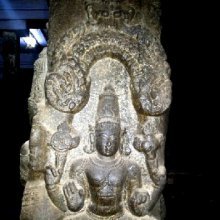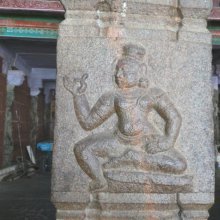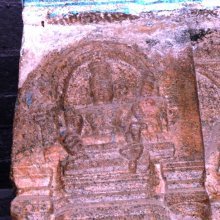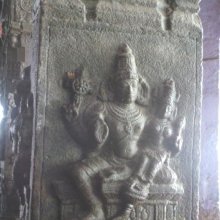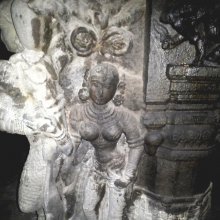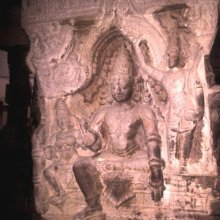Saṃdaṃśa, Saṃdaṃsa, Samdamsa, Samdamsha, Sandamsa: 13 definitions
Introduction:
Saṃdaṃśa means something in Hinduism, Sanskrit, Jainism, Prakrit, Hindi. If you want to know the exact meaning, history, etymology or English translation of this term then check out the descriptions on this page. Add your comment or reference to a book if you want to contribute to this summary article.
The Sanskrit term Saṃdaṃśa can be transliterated into English as Samdamsa or Samdamsha, using the IAST transliteration scheme (?).
Alternative spellings of this word include Sandansh.
Images (photo gallery)
(+6 more images available)
In Hinduism
Natyashastra (theatrics and dramaturgy)
Source: archive.org: The mirror of gesture (abhinaya-darpana)One of the Twenty-eight Single Hands (hasta):—Saṃdaṃsa (grasping): the fingers of the Padmakośa hand arerepeatedly opened and closed. Usage: generosity, sacrificialofferings, tumour, insect, apprehension, worship (arcana), the number five.
According to another book: the middle finger of the Haṃsāsyahand is outstretched. This hand originates from the Goddess of Speech, when she bestowed a rosary. Its sage is Viśvavāsu, its race Vidhyādhara, its colour white, its patron deity Vālmīki. Usage: tooth, small bud, singing (saṃgīta) , gentle dances (lāsyanaṭana), exegesis (ṭīka), jñāna-mudrā, scales, flaw in a tooth, sacred thread (yajñopavīta) , line, examining, painting pictures (citra-lekhana), truth, saying “No!”, saying “A little”, moment,listening, testing metals etc. on the touchstone (nikaṣa), shining white, taking aim, nail, sprout, gunja seed, the number eight, fire-fly, poison, blades of grass, red ants, mosquito, eclipse, collecting pearls, bug, fly, garland, down, pointing (sūcana), solitude, touching, Veda, snow, speaking, slipping, cutting off, a wound,brow-spot, collyrium, Vidyādhara caste, white colour, slowness.
Note: In this case, exceptionally, the definition quoted “from other books” differs markedly from that of Nandikeśvara: this form of Saṃdaṃsa hand is identicalwith Nandikeśvara’s Haṃsāsya hand, and is quite distinct in form and significance from his Saṃdaṃsa.

Natyashastra (नाट्यशास्त्र, nāṭyaśāstra) refers to both the ancient Indian tradition (shastra) of performing arts, (natya—theatrics, drama, dance, music), as well as the name of a Sanskrit work dealing with these subjects. It also teaches the rules for composing Dramatic plays (nataka), construction and performance of Theater, and Poetic works (kavya).
Shaktism (Shakta philosophy)
Source: Wisdom Library: Śrīmad Devī BhāgavatamSaṃdaṃśa (संदंश) refers to one of the thirty hells (naraka) mentioned in the Devī-bhāgavata-purāṇa 8.21 (on the narrative of hells). The hells are destinations where dead beings brought by messengers of Yama (the God of the Pitṛs), and get punished by him according to their karmas and faults.
The Devī-bhāgavata-purāṇa or Śrīmad-devī-bhāgavatam (mentioning Saṃdaṃśa), is categorised as a Mahāpurāṇa, a type of Sanskrit literature containing cultural information on ancient India, religious/spiritual prescriptions and a range of topics concerning the various arts and sciences. The whole text is composed of 18,000 metrical verses, possibly originating from before the 6th century.

Shakta (शाक्त, śākta) or Shaktism (śāktism) represents a tradition of Hinduism where the Goddess (Devi) is revered and worshipped. Shakta literature includes a range of scriptures, including various Agamas and Tantras, although its roots may be traced back to the Vedas.
Ayurveda (science of life)
Source: gurumukhi.ru: Ayurveda glossary of termsSaṃdaṃśa (संदंश):—An apparatus for holding

Āyurveda (आयुर्वेद, ayurveda) is a branch of Indian science dealing with medicine, herbalism, taxology, anatomy, surgery, alchemy and related topics. Traditional practice of Āyurveda in ancient India dates back to at least the first millenium BC. Literature is commonly written in Sanskrit using various poetic metres.
Shaivism (Shaiva philosophy)
Source: SOAS University of London: Protective Rites in the Netra TantraSaṃdaṃśa (संदंश) refers to a “clamp”, according to the Netratantra of Kṣemarāja: a Śaiva text from the 9th century in which Śiva (Bhairava) teaches Pārvatī topics such as metaphysics, cosmology, and soteriology.—Accordingly, [verse 13.25cd-28, while describing the appearance and worship of Viśvakarman]—“Furthermore, [I shall describe] Viśvakarman, the Lord of the world. [He] is bright as a ray of light, risen alone [i.e., from itself]. [Viśvakarman] has [either] two or four arms. [When he has four hands he] bears a stone cutter’s chisel and a book with [his] beautiful right hand. [In the left he holds] a clamp (saṃdaṃśa) and a cord. [...]”.

Shaiva (शैव, śaiva) or Shaivism (śaivism) represents a tradition of Hinduism worshiping Shiva as the supreme being. Closely related to Shaktism, Shaiva literature includes a range of scriptures, including Tantras, while the root of this tradition may be traced back to the ancient Vedas.
Languages of India and abroad
Sanskrit dictionary
Source: DDSA: The practical Sanskrit-English dictionarySaṃdaṃśa (संदंश).—
1) A pair of tongs; अयस्मयैरग्निपिण्डैः संदंशैस्त्वचि निष्कुषन्ति (ayasmayairagnipiṇḍaiḥ saṃdaṃśaistvaci niṣkuṣanti) Bhāgavata 5.26.19.
2) Too great compression of the teeth in the pronunciation of vowels (or letters).
3) Name of those parts of the body used for grasping.
4) Name of a hell.
5) A chapter or section of a book.
6) The side of a village.
Derivable forms: saṃdaṃśaḥ (संदंशः).
Source: Cologne Digital Sanskrit Dictionaries: Benfey Sanskrit-English DictionarySaṃdaṃśa (संदंश).—i. e. sam-daṃś + a, m. A pair of tongs, [Pañcatantra] 52, 8 (sva -daśana-, His claws which are like a pair of nippers).
Source: Cologne Digital Sanskrit Dictionaries: Cappeller Sanskrit-English DictionarySaṃdaṃśa (संदंश).—[masculine] biting or pinching together (the (lips); junction, union i.[grammar]; crotchet, tongs, or any instrument of that kind.
Source: Cologne Digital Sanskrit Dictionaries: Monier-Williams Sanskrit-English Dictionary1) Saṃdaṃśa (संदंश):—[=saṃ-daṃśa] [from saṃ-daṃś] m. compression (of the lips), [Mahābhārata]
2) [v.s. ...] too great compression of the teeth in the pronunciation of vowels, [Ṛgveda-prātiśākhya]
3) [v.s. ...] junction, connection, [Subhāṣitāvali]
4) [v.s. ...] a pair of tongs or pincers or nippers, [Atharva-veda; Brāhmaṇa; Purāṇa; Suśruta]
5) [v.s. ...] Name of those parts of the body which are used for grasping or seizing (as the thumb and forefinger together, the opposite eye-teeth, the nippers of a crab etc.), [Yājñavalkya; Varāha-mihira’s Bṛhat-saṃhitā; Suśruta; Pañcatantra; Kathāsaritsāgara]
6) [v.s. ...] a [particular] Naraka or hell (where the flesh of the wicked is tortured with pincers), [Purāṇa]
7) [v.s. ...] a chapter or section of a book, [Dāyabhāga]
8) [v.s. ...] a [particular] Ekāha, [Vaitāna-sūtra]
9) [v.s. ...] the site of a village etc. (fixed according to the compass), [cf. Lexicographers, esp. such as amarasiṃha, halāyudha, hemacandra, etc.]
Source: DDSA: Paia-sadda-mahannavo; a comprehensive Prakrit Hindi dictionary (S)Saṃdaṃśa (संदंश) in the Sanskrit language is related to the Prakrit words: Saṃḍāsa, Saṃdaṃsa.
[Sanskrit to German]
Sanskrit, also spelled संस्कृतम् (saṃskṛtam), is an ancient language of India commonly seen as the grandmother of the Indo-European language family (even English!). Closely allied with Prakrit and Pali, Sanskrit is more exhaustive in both grammar and terms and has the most extensive collection of literature in the world, greatly surpassing its sister-languages Greek and Latin.
Hindi dictionary
Source: DDSA: A practical Hindi-English dictionarySaṃdaṃśa (संदंश) [Also spelled sandansh]:—(nm) forceps; sting.
...
Prakrit-English dictionary
Source: DDSA: Paia-sadda-mahannavo; a comprehensive Prakrit Hindi dictionarySaṃdaṃsa (संदंस) in the Prakrit language is related to the Sanskrit word: Saṃdaṃśa.
Prakrit is an ancient language closely associated with both Pali and Sanskrit. Jain literature is often composed in this language or sub-dialects, such as the Agamas and their commentaries which are written in Ardhamagadhi and Maharashtri Prakrit. The earliest extant texts can be dated to as early as the 4th century BCE although core portions might be older.
Kannada-English dictionary
Source: Alar: Kannada-English corpusSaṃdaṃśa (ಸಂದಂಶ):—
1) [noun] a joining or being joined; a junction; a connection.
2) [noun] a pair of tongs, pincers or nippers.
3) [noun] the thumb and forefinger (together or individually) which are used for grasping or seizing.
4) [noun] the act or an instance of biting one’s lips.
5) [noun] a pressing of both the lips togther while pronouncing some letters.
6) [noun] either of the two pointed teeth in the upper jaw of a horse; an eye-tooth.
7) [noun] (myth.) name of a hell.
8) [noun] (dance.) a posture of the hand, in which the tip of the forefinger is placed on the tip of the thumb, other fingers stretched and separated from each other, the palm is sunken and hollowed a little.
Kannada is a Dravidian language (as opposed to the Indo-European language family) mainly spoken in the southwestern region of India.
See also (Relevant definitions)
Full-text (+21): Sandamsha, Samdamshaka, Samdamshika, Mukhasamdamsha, Samdisha, Sandisa, Karasamdamshahinaka, Vakula, Samdamshita, Sandasa, Angulisamdesha, Sandansh, Svacchika, Karasamdamsha, Samdashta, Shvashru, Abhicarayajna, Mukhaja, Agraja, Parshvakrita.
Relevant text
Search found 16 books and stories containing Saṃdaṃśa, Saṃ-daṃśa, Sam-damsa, Sam-damsha, Saṃdaṃsa, Samdamsa, Samdamsha, Sandamsa, Sandaṃsa, Sandaṃśa, Sandamśa, Sandamsha; (plurals include: Saṃdaṃśas, daṃśas, damsas, damshas, Saṃdaṃsas, Samdamsas, Samdamshas, Sandamsas, Sandaṃsas, Sandaṃśas, Sandamśas, Sandamshas). You can also click to the full overview containing English textual excerpts. Below are direct links for the most relevant articles:
Shishupala-vadha (Study) (by Shila Chakraborty)
Citrakāvya (1): Yamaka < [Introduction]
Abhinaya-darpana (English) (by Ananda Coomaraswamy)
Chapter 16 - Hands denoting Relationships
Chapter 25 - Hands denoting Trees
The Shiva Purana (by J. L. Shastri)
Chapter 16 - Uplift from the hell < [Section 5 - Umā-Saṃhitā]
Vishnudharmottara Purana (Art and Architecture) (by Bhagyashree Sarma)
2.2. Hand Postures (a): Asaṃyukta-hasta < [Chapter 3 - Drama and Dance]
The Skanda Purana (by G. V. Tagare)
Chapter 12 - The Greatness of Svāmipuṣkariṇī: Redemption from Hells < [Section 1 - Veṅkaṭācala-māhātmya]
Chapter 29 - The Great Efficacy of Anaraka Tīrtha < [Section 1 - Avantīkṣetra-māhātmya]
Chapter 30 - The Glory of Dhanuṣkoṭi < [Section 1 - Setu-māhātmya]
Natyashastra (English) (by Bharata-muni)
